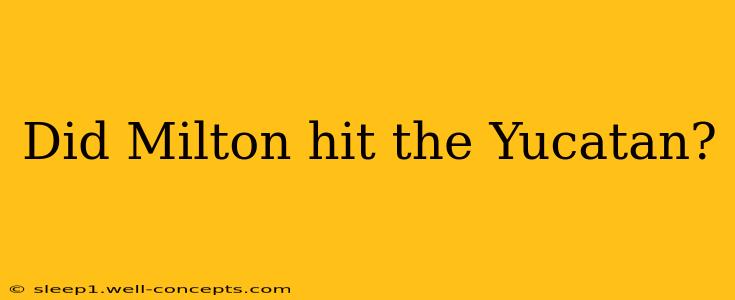The question, "Did Milton hit the Yucatan?" is intriguing, especially for those familiar with both the Chicxulub impactor and Mayan cosmology. While there's no known historical figure or event called "Milton" associated with a Yucatan impact, the query hints at the larger, fascinating intersection of scientific discoveries and ancient narratives surrounding catastrophic events. Let's delve into the mysteries this question subtly raises.
The Chicxulub Impactor: A Scientific Certainty
The scientific community overwhelmingly accepts the Chicxulub impactor as the primary cause of the Cretaceous-Paleogene (K-Pg) extinction event, approximately 66 million years ago. Evidence strongly points to a massive asteroid or comet striking the Yucatan Peninsula, creating the Chicxulub crater, a roughly 180-kilometer-wide scar beneath the surface. This impact triggered widespread devastation, including tsunamis, wildfires, and a prolonged "impact winter" that dramatically altered the Earth's climate and led to the extinction of the dinosaurs, among other species.
Scientific Evidence Supporting the Chicxulub Impact
The evidence for the Chicxulub impact is compelling and multifaceted:
- The Crater: Geophysical surveys have conclusively mapped the Chicxulub crater, confirming its size and impact origin.
- Impact Ejecta: Layers of sediment containing shocked quartz, tektites (glassy rocks formed by impact), and iridium (an element rare on Earth but common in asteroids) are found globally, dating to the K-Pg boundary.
- Geological Anomalies: The geological record shows significant disturbances in rock strata around the Yucatan Peninsula, consistent with a massive impact.
Mayan Mythology and Catastrophic Events
Mayan mythology contains rich narratives about catastrophic events, including floods, earthquakes, and celestial occurrences. While these stories aren't directly tied to the Chicxulub impact (due to the vast temporal difference), they do reflect a cultural awareness of powerful natural forces capable of causing widespread destruction. These myths serve as valuable insights into how ancient societies interpreted and responded to such events.
Interpreting Mayan Cosmology
Understanding Mayan cosmology requires careful consideration of their cyclical worldview and intricate calendar systems. Their creation myths often involve periods of destruction and renewal, reflecting a deeper understanding of the impermanence of the world and the potential for cataclysmic change. However, connecting specific myths to the Chicxulub impact requires significant interpretation and lacks direct textual evidence.
The Gap Between Myth and Science
The disparity between the precise scientific dating of the Chicxulub impact and the timelines of Mayan mythology presents a significant challenge in connecting the two. Mayan civilization flourished long after the K-Pg extinction event. Therefore, while Mayan narratives might allude to catastrophic events, directly linking them to the Chicxulub impact requires considerable speculation.
Future Research and Potential Connections
Ongoing research in both paleontology and Mayan studies may uncover further connections. Future discoveries could shed light on how the environmental consequences of the Chicxulub impact might have influenced subsequent civilizations and their cultural narratives.
Conclusion: A Question of Interpretation
While "Milton" doesn't appear in the scientific record of the Yucatan impact, the question itself highlights the broader fascination with connecting ancient narratives to scientific discoveries. The Chicxulub impact is a scientifically established event, while the interpretation of its influence on Mayan mythology remains a subject of ongoing scholarly debate and interpretation. The intersection of scientific findings and cultural narratives continues to offer valuable insights into both our understanding of Earth's history and the resilience of human societies in the face of catastrophic events.

